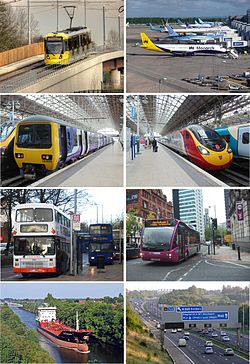| Transportation in Greater Manchester | |
|---|---|
 | |
| Overview | |
| Locale | Greater Manchester |
| Transit type | Buses, car, cycling, airport, commuter rail, tram, tram-train, high speed rail (proposed) |
| Number of lines | Bus routes: 600+ Tram: 8 Rail: 16 |
| Number of stations | Bus stops: 12,000 Tram stops: 99 Train stations: 101 |
| Daily ridership | 824,657 (2014)[1] |
| Operation | |
| Operator(s) | Transport for Greater Manchester (TfGM) |
The transport infrastructure of Greater Manchester is built up of numerous transport modes and forms an integral part of the structure of Greater Manchester and North West England – the most populated region outside of South East England which had approximately 301 million annual passenger journeys using either buses, planes, trains or trams in 2014.[2] Its position as a national city of commerce, education and cultural importance means the city has one of the largest and most thorough transport infrastructures which is heavily relied upon by its 2.8 million inhabitants in the Greater Manchester conurbation and further afield in the North West region. Public transport comes under the jurisdiction of Transport for Greater Manchester.
Greater Manchester has a higher percentage of the motorway network than any other county.[3] According to the Guinness Book of World Records, it has the most traffic lanes side by side (17), spread across several parallel carriageways – the M61 at Linnyshaw Moss, Greater Manchester,[citation needed] close to the M60 interchange. The M60 is one of only two motorways in the UK designated as an 'Orbital Motorway', (the other being the M25 around London).
Greater Manchester still has an extensive citywide rail network compared with other British cities with over 200 tram and train stations - much of which dates from the Industrial Revolution. Two mainline termini (Piccadilly and Victoria) and four through mainline railway stations in the central area (Deansgate, Oxford Road, Salford Central and Salford Crescent) form the Manchester station group. Ultimately, Manchester sits at a rail bottleneck, and it is hoped investment in the proposed Northern Hub from 2013 to 2019 by Network Rail will alleviate this.[needs update]
Manchester Airport is the third busiest airport in the United Kingdom after Heathrow and Gatwick. The city also has an extensive network of canal systems which converge into Manchester. The Manchester Ship Canal, built in 1894, was the largest ship canal in the world on opening and is incomparable to any other canal in the United Kingdom, which are mostly built for narrowboats and barges.
It was the first city in the United Kingdom to re-introduce trams to the streets with the 1992 opening of Manchester Metrolink, which is currently undergoing significant extension and is now the largest network in the UK, having surpassed the Tyne & Wear Metro.[4] As of January 2022 it has 99 stops, with the line to the Trafford Centre having opened in March 2020. No underground system exists in Manchester, however this was proposed on numerous occasions before the Metrolink tram system was built, the GMCA have stated that the city will need a metro system in the future to meet the city's growing population.
- ^ "Facts & Figures". Transport for Greater Manchester (TfGM). Archived from the original on 4 July 2015. Retrieved 26 November 2014.
- ^ "Transport for Greater Manchester Facts & Figures". tfgm.com. Transport for Greater Manchester 2015. Archived from the original on 4 July 2015. Retrieved 10 October 2015.
- ^ The Metropolitan County of Greater Manchester has the most extensive motorway network in the United Kingdom. Archived 9 October 2006 at the Wayback Machine Oldham College -About Manchester URL accessed 28 June 2007
- ^ "Future extensions". Transport for Greater Manchester. Retrieved 19 May 2013.
By 2014 the expansion programme will mean Greater Manchester will have the largest tram network in the UK.
